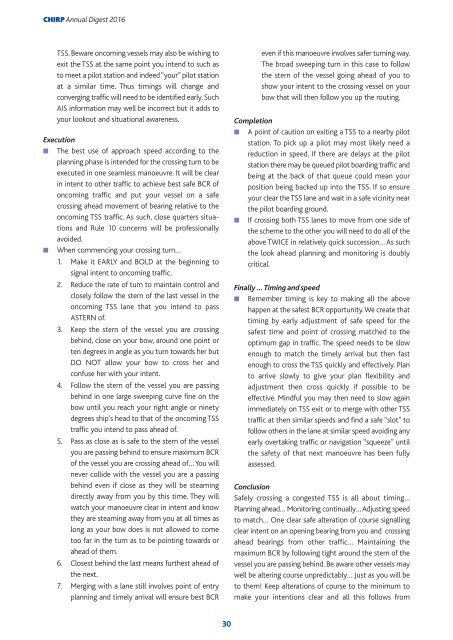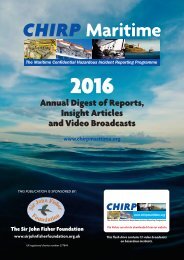CHIRP annual digest 2016 6th
You also want an ePaper? Increase the reach of your titles
YUMPU automatically turns print PDFs into web optimized ePapers that Google loves.
<strong>CHIRP</strong> Annual Digest <strong>2016</strong><br />
TSS. Beware oncoming vessels may also be wishing to<br />
exit the TSS at the same point you intend to such as<br />
to meet a pilot station and indeed “your” pilot station<br />
at a similar time. Thus timings will change and<br />
converging traffic will need to be identified early. Such<br />
AIS information may well be incorrect but it adds to<br />
your lookout and situational awareness.<br />
Execution<br />
■ The best use of approach speed according to the<br />
planning phase is intended for the crossing turn to be<br />
executed in one seamless manoeuvre. It will be clear<br />
in intent to other traffic to achieve best safe BCR of<br />
oncoming traffic and put your vessel on a safe<br />
crossing ahead movement of bearing relative to the<br />
oncoming TSS traffic. As such, close quarters situa -<br />
tions and Rule 10 concerns will be professionally<br />
avoided.<br />
■ When commencing your crossing turn…<br />
1. Make it EARLY and BOLD at the beginning to<br />
signal intent to oncoming traffic.<br />
2. Reduce the rate of turn to maintain control and<br />
closely follow the stern of the last vessel in the<br />
oncoming TSS lane that you intend to pass<br />
ASTERN of.<br />
3. Keep the stern of the vessel you are crossing<br />
behind, close on your bow, around one point or<br />
ten degrees in angle as you turn towards her but<br />
DO NOT allow your bow to cross her and<br />
confuse her with your intent.<br />
4. Follow the stern of the vessel you are passing<br />
behind in one large sweeping curve fine on the<br />
bow until you reach your right angle or ninety<br />
degrees ship’s head to that of the oncoming TSS<br />
traffic you intend to pass ahead of.<br />
5. Pass as close as is safe to the stern of the vessel<br />
you are passing behind to ensure maximum BCR<br />
of the vessel you are crossing ahead of… You will<br />
never collide with the vessel you are a passing<br />
behind even if close as they will be steaming<br />
directly away from you by this time. They will<br />
watch your manoeuvre clear in intent and know<br />
they are steaming away from you at all times as<br />
long as your bow does is not allowed to come<br />
too far in the turn as to be pointing towards or<br />
ahead of them.<br />
6. Closest behind the last means furthest ahead of<br />
the next.<br />
7. Merging with a lane still involves point of entry<br />
planning and timely arrival will ensure best BCR<br />
even if this manoeuvre involves safer turning way.<br />
The broad sweeping turn in this case to follow<br />
the stern of the vessel going ahead of you to<br />
show your intent to the crossing vessel on your<br />
bow that will then follow you up the routing.<br />
Completion<br />
■ A point of caution on exiting a TSS to a nearby pilot<br />
station. To pick up a pilot may most likely need a<br />
reduction in speed. If there are delays at the pilot<br />
station there may be queued pilot boarding traffic and<br />
being at the back of that queue could mean your<br />
position being backed up into the TSS. If so ensure<br />
your clear the TSS lane and wait in a safe vicinity near<br />
the pilot boarding ground.<br />
■ If crossing both TSS lanes to move from one side of<br />
the scheme to the other you will need to do all of the<br />
above TWICE in relatively quick succession… As such<br />
the look ahead planning and monitoring is doubly<br />
critical.<br />
Finally … Timing and speed<br />
■ Remember timing is key to making all the above<br />
happen at the safest BCR opportunity. We create that<br />
timing by early adjustment of safe speed for the<br />
safest time and point of crossing matched to the<br />
optimum gap in traffic. The speed needs to be slow<br />
enough to match the timely arrival but then fast<br />
enough to cross the TSS quickly and effectively. Plan<br />
to arrive slowly to give your plan flexibility and<br />
adjustment then cross quickly if possible to be<br />
effective. Mindful you may then need to slow again<br />
immediately on TSS exit or to merge with other TSS<br />
traffic at then similar speeds and find a safe “slot” to<br />
follow others in the lane at similar speed avoiding any<br />
early overtaking traffic or navigation “squeeze” until<br />
the safety of that next manoeuvre has been fully<br />
assessed.<br />
Conclusion<br />
Safely crossing a congested TSS is all about timing…<br />
Planning ahead… Monitoring continually… Adjusting speed<br />
to match… One clear safe alteration of course signalling<br />
clear intent on an opening bearing from you and crossing<br />
ahead bearings from other traffic… Maintaining the<br />
maximum BCR by following tight around the stern of the<br />
vessel you are passing behind. Be aware other vessels may<br />
well be altering course unpredictably… Just as you will be<br />
to them! Keep alterations of course to the minimum to<br />
make your intentions clear and all this follows from<br />
30



